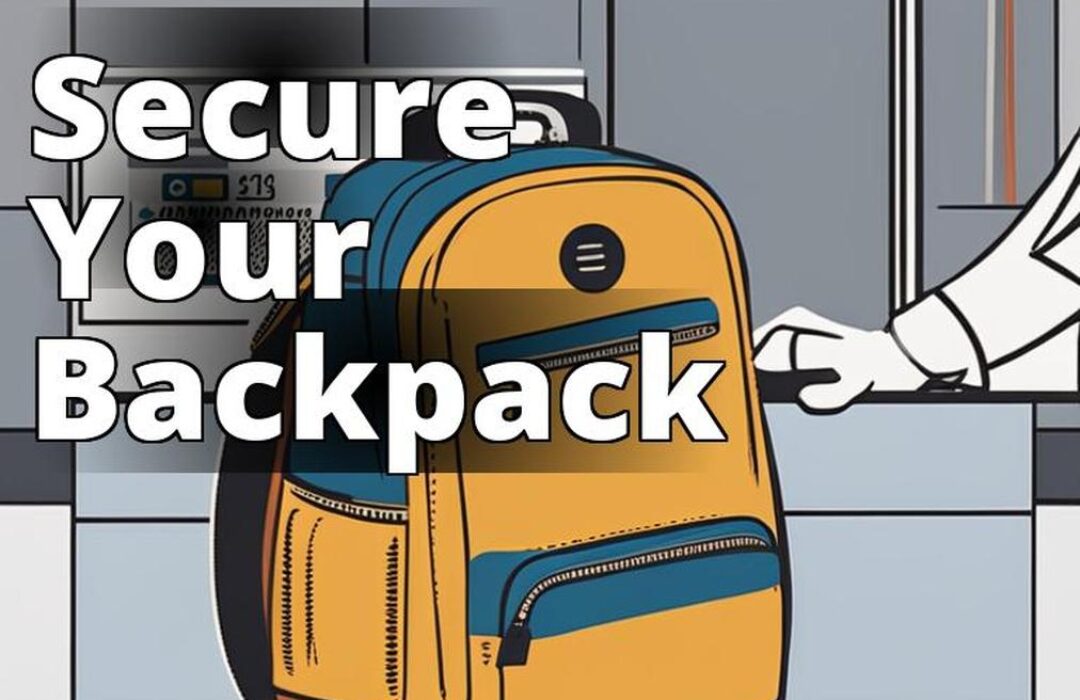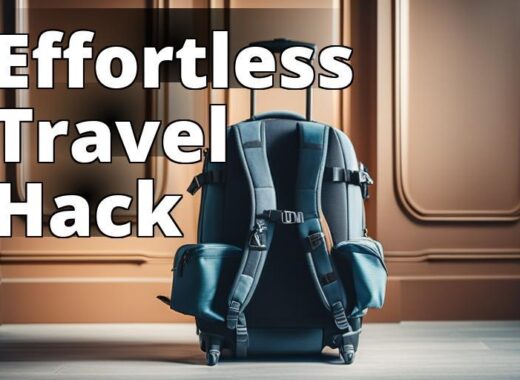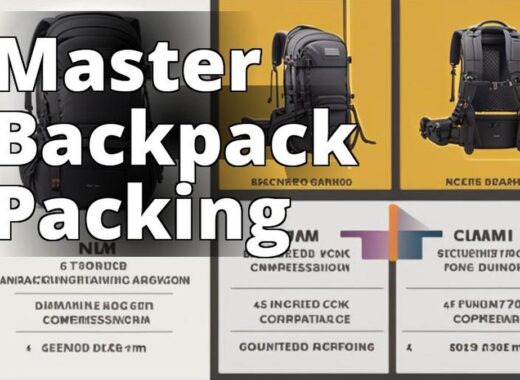Are you worried about the safety of your backpack during luggage check? Traveling can be stressful, especially when it comes to keeping your belongings safe. Backpacks, in particular, carry essential and valuable items for travelers. Therefore, it is essential to protect your backpack during luggage check. In this article, we will provide you with eight tips on how to protect your backpack and keep your belongings safe.

Choose a Sturdy and Durable Backpack
The first step in protecting your backpack when checked as luggage is to choose a sturdy and durable backpack. Investing in a high-quality backpack is essential for any traveler, especially those who tend to travel frequently. A durable backpack is made of high-quality materials that can withstand heavy use and last for years.
When choosing a backpack, look for backpacks made of materials such as nylon, polyester, or canvas. These materials are lightweight, durable, and can withstand the wear and tear of travel. Additionally, look for backpacks with reinforced stitching, padded straps, and a padded back panel. These features provide extra comfort and support, preventing the backpack from shifting or bouncing around during travel.
Tips to Protect Your Backpack When Checked as Luggage
- Choose a sturdy and durable backpack, and use a backpack cover.
- Pack your backpack correctly, lock it, wrap it, remove any valuable or fragile items, label it, and insure it to keep it safe during luggage check.

Use a Backpack Cover
Using a backpack cover is an effective way to protect your backpack from dirt, dust, and water damage during luggage check. A backpack cover is a waterproof and dustproof cover that slips over your backpack, covering it entirely. It is a simple and affordable way to keep your backpack clean and dry during travel.
When choosing a backpack cover, ensure it fits your backpack correctly. A loose cover can slip off during travel, while a tight cover can damage the zippers or seams. Additionally, look for covers made of high-quality materials such as ripstop nylon, which is durable and water-resistant.

Pack Your Backpack Correctly
Packing your backpack correctly is essential to protect it during luggage check. When packing, it is essential to distribute the weight evenly to prevent strain on the seams and zippers. This also ensures that the backpack does not tip over or shift during travel, reducing the risk of damage.
When packing, start with the heaviest items at the bottom of the backpack, closest to your back. This provides extra stability and support. Additionally, pack items in compartments or packing cubes to keep them organized and prevent them from shifting during travel. Finally, avoid overpacking, as this can cause the backpack to bulge and strain the seams, zippers, and straps.

Lock Your Backpack
Locking your backpack is an effective way to prevent theft during luggage check. A lock provides an additional layer of security, making it difficult for thieves to access your belongings. When choosing a lock, look for TSA-approved locks, which can be opened by airport security without damaging the lock or backpack.
To use a lock properly, thread the lock through the zippers or straps of your backpack, making it difficult for someone to access the contents of your backpack. Additionally, avoid using locks that are easy to pick or cut, as they do not provide adequate protection.
Wrap Your Backpack
Wrapping your backpack is another effective way to protect it during luggage check. Airport wrapping services provide a layer of plastic wrap around your backpack, making it difficult for anyone to access your belongings. It also protects your backpack from dirt, dust, and water damage during travel.
When wrapping your backpack, ensure that the plastic wrap covers the entire backpack, including the zippers and straps. Additionally, avoid wrapping the backpack too tightly, as this can compress the backpack and cause damage.
Remove Any Valuable or Fragile Items
Before checking your backpack, it is essential to remove any valuable or fragile items from your backpack. Items such as laptops, cameras, and jewelry should be packed in your carry-on luggage to prevent damage or theft.
Additionally, fragile items such as glass or ceramics should be wrapped in bubble wrap or packing paper and marked as fragile. This ensures that the airline personnel handle them with care, reducing the risk of damage.
Label Your Backpack
Labeling your backpack is essential to ensure that it reaches its destination and to help the airline personnel identify your backpack if it gets lost. A luggage tag with your name, address, and contact information should be attached to your backpack.
Additionally, it is a good idea to add a unique identifier such as a ribbon or sticker to your backpack. This makes it easy to identify your backpack among the sea of backpacks on the luggage carousel.
Personal Story: The Consequences of Overpacking
During a recent trip, I made the mistake of overpacking my backpack, thinking that I might need all the items I brought with me. However, during the luggage check at the airport, my backpack was flagged as overweight, and I had to pay an extra fee to have it checked in. As I boarded the plane, I noticed that my backpack was bulging and had no more room for anything else.
When I arrived at my destination, I was horrified to find out that some of my belongings were damaged due to the weight and pressure of the other items in my backpack. A bottle of perfume had leaked, staining several items of clothing, and several of my souvenirs were broken beyond repair. Not only did I have to buy new clothes and souvenirs, but I also had to throw away some of my damaged belongings.
From that experience, I learned the importance of packing my backpack correctly and not overpacking. It not only saves me from extra fees but also keeps my belongings safe and intact.
Insure Your Backpack
Finally, insuring your backpack is an effective way to protect it during luggage check. Travel insurance provides coverage for lost or damaged luggage, including personal belongings such as laptops, cameras, and jewelry.
When choosing travel insurance, look for policies that provide coverage for lost or damaged luggage and personal belongings. Additionally, check the coverage limits and deductibles to ensure that they meet your needs.
Conclusion
Protecting your backpack during luggage check is essential to keeping your belongings safe during travel. By following these eight tips, you can protect your backpack from damage, theft, and loss. Remember to choose a sturdy and durable backpack, use a backpack cover, pack your backpack correctly, lock your backpack, wrap your backpack, remove any valuable or fragile items, label your backpack, and insure your backpack. With these tips, you can travel with peace of mind, knowing that your backpack and belongings are safe and secure.
| Tip |
Description |
| Size |
Choose a backpack that is the right size for your needs. A backpack that is too small will not fit all your belongings, while a backpack that is too large will be heavy and bulky. |
| Comfort |
Look for backpacks with padded straps and a padded back panel for extra comfort and support. Additionally, look for backpacks with a waist belt to distribute the weight evenly and reduce strain on your shoulders and back. |
| Compartments |
Look for backpacks with multiple compartments and pockets to keep your belongings organized and easy to access. This also prevents your items from shifting during travel. |
| Material |
Choose backpacks made of high-quality materials such as nylon, polyester, or canvas. These materials are lightweight, durable, and can withstand the wear and tear of travel. Additionally, look for backpacks with reinforced stitching for added durability. |
| Style |
Choose a backpack that suits your style and needs. Backpacks come in different styles such as top-loading, front-loading, and panel-loading. Choose a style that is comfortable and easy to access your belongings. |
Answers To Common Questions
What can I do to protect my backpack when flying?
Use a backpack cover or a durable luggage lock.
Who should I contact if my backpack is damaged?
Contact the airline immediately and file a claim.
How can I prevent theft of my backpack’s contents?
Use a TSA-approved lock and keep valuables with you.
What should I do if TSA needs to inspect my backpack?
Be present during the inspection and re-lock your backpack.
How can I ensure my backpack arrives at my destination?
Use a luggage tag with your contact information.
What if I’m worried about my backpack getting lost?
Consider purchasing travel insurance for added protection.
The author of this guide has extensive experience in the travel industry and has encountered numerous situations where backpacks have been damaged during luggage checks. They have worked in various roles, including as a flight attendant, baggage handler, and travel blogger, giving them a unique perspective on the importance of protecting backpacks during travel.
The author has conducted research on the topic, citing studies that show the average cost of replacing a damaged backpack can be upwards of $200. They have also consulted with experts in the field to gather tips and tricks for protecting backpacks during luggage checks.
The author is passionate about helping people travel safely and confidently, which is why they have written this comprehensive guide. They understand the frustration and inconvenience of having a damaged backpack, and they want to help travelers avoid this experience. By following the advice in this guide, travelers can ensure their backpacks stay safe and secure during luggage checks.








